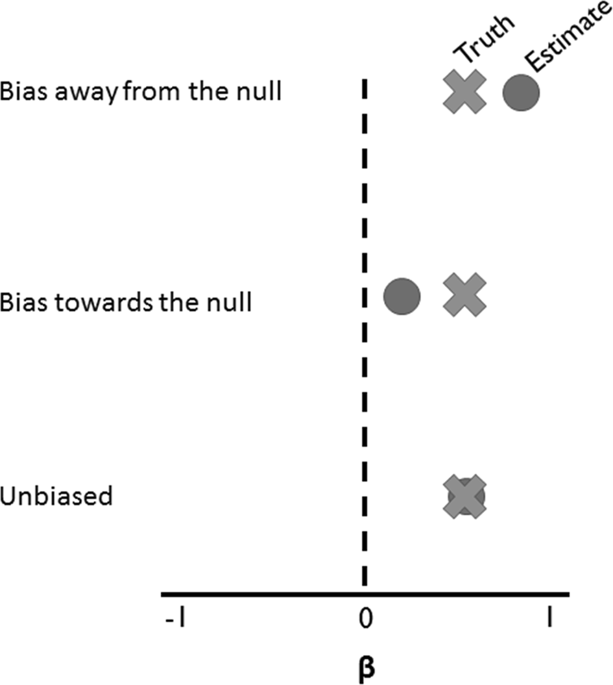当前位置:
X-MOL 学术
›
J. Expo. Sci. Environ. Epid.
›
论文详情
Our official English website, www.x-mol.net, welcomes your feedback! (Note: you will need to create a separate account there.)
Influence of exposure measurement errors on results from epidemiologic studies of different designs.
Journal of Exposure Science and Environmental Epidemiology ( IF 4.5 ) Pub Date : 2019-09-02 , DOI: 10.1038/s41370-019-0164-z Jennifer Richmond-Bryant 1, 2 , Thomas C Long 1
Journal of Exposure Science and Environmental Epidemiology ( IF 4.5 ) Pub Date : 2019-09-02 , DOI: 10.1038/s41370-019-0164-z Jennifer Richmond-Bryant 1, 2 , Thomas C Long 1
Affiliation

|
In epidemiologic studies of health effects of air pollution, measurements or models are used to estimate exposure. Exposure estimates have errors that propagate to effect estimates in exposure-response models. We critically evaluate how types of exposure measurement error influenced bias and precision of effect estimates to understand conditions affecting interpretation of exposure-response models for epidemiologic studies of exposure to PM2.5, NO2, and SO2. We reviewed available literature on exposure measurement error for time-series and long-term exposure epidemiology studies. For time-series studies, time-activity error (daily exposure concentration did not account for variation in exposure due to time-activity during a day) and nonambient (indoor) sources negatively biased the effect estimates and increased standard error, so uncertainty grew with increasing bias while underestimating the true health effect in these studies. Spatial error (deviation between true exposure concentration at an individual's location and concentration at a receptor) was ascribed to negatively biased effect estimates in most cases. Positive bias occurred for spatially variable pollutants when the variance of error correlated with the exposure estimate. For long-term exposure studies, most spatial errors did not bias the effect estimate. For both time-series and long-term exposure studies reviewed, large uncertainties were observed when exposure concentration was modeled with low spatial and temporal resolution for a spatially variable pollutant.
中文翻译:

暴露测量误差对不同设计的流行病学研究结果的影响。
在空气污染对健康的影响的流行病学研究中,使用测量或模型来估计暴露量。暴露估计存在误差,这些误差会传播到暴露响应模型中的影响估计。我们严格评估暴露测量误差的类型如何影响效果估计的偏差和精度,以了解影响暴露于PM2.5,NO2和SO2的流行病学研究的暴露反应模型解释的条件。我们回顾了有关时间序列和长期暴露流行病学研究的暴露测量误差的现有文献。对于时间序列研究,时间活动性误差(每天的暴露浓度未考虑到由于一天中时间活动而引起的暴露变化),并且非环境(室内)源会对效果估计值产生负面影响,并增加标准误差,因此不确定性随着偏见的增加而增加,同时低估了这些研究的真实健康影响。在大多数情况下,空间误差(个体位置的真实暴露浓度与受体浓度之间的偏差)归因于负面估计的影响。当误差的方差与暴露估计值相关时,空间可变污染物会出现正偏差。对于长期暴露研究,大多数空间误差均不会影响效果估计。对于回顾的时间序列和长期暴露研究,当以低时空分辨率对空间可变污染物建模暴露浓度时,观察到很大的不确定性。在大多数情况下,空间误差(个体位置的真实暴露浓度与受体浓度之间的偏差)归因于负面估计的影响。当误差的方差与暴露估计值相关时,空间可变污染物会出现正偏差。对于长期暴露研究,大多数空间误差均不会影响效果估计。对于回顾的时间序列和长期暴露研究,当以低时空分辨率对空间可变污染物建模暴露浓度时,观察到很大的不确定性。在大多数情况下,空间误差(个体位置的真实暴露浓度与受体浓度之间的偏差)归因于负面估计的影响。当误差的方差与暴露估计值相关时,空间可变污染物会出现正偏差。对于长期暴露研究,大多数空间误差均不会影响效果估计。对于回顾的时间序列和长期暴露研究,当以低时空分辨率对空间可变污染物建模暴露浓度时,观察到很大的不确定性。当误差的方差与暴露估计值相关时,空间可变污染物会出现正偏差。对于长期暴露研究,大多数空间误差均不会影响效果估计。对于回顾的时间序列和长期暴露研究,当以低时空分辨率对空间可变污染物建模暴露浓度时,观察到很大的不确定性。当误差的方差与暴露估计值相关时,空间可变污染物会出现正偏差。对于长期暴露研究,大多数空间误差均不会影响效果估计。对于回顾的时间序列和长期暴露研究,当以低时空分辨率对空间可变污染物建模暴露浓度时,观察到很大的不确定性。
更新日期:2019-09-03
中文翻译:

暴露测量误差对不同设计的流行病学研究结果的影响。
在空气污染对健康的影响的流行病学研究中,使用测量或模型来估计暴露量。暴露估计存在误差,这些误差会传播到暴露响应模型中的影响估计。我们严格评估暴露测量误差的类型如何影响效果估计的偏差和精度,以了解影响暴露于PM2.5,NO2和SO2的流行病学研究的暴露反应模型解释的条件。我们回顾了有关时间序列和长期暴露流行病学研究的暴露测量误差的现有文献。对于时间序列研究,时间活动性误差(每天的暴露浓度未考虑到由于一天中时间活动而引起的暴露变化),并且非环境(室内)源会对效果估计值产生负面影响,并增加标准误差,因此不确定性随着偏见的增加而增加,同时低估了这些研究的真实健康影响。在大多数情况下,空间误差(个体位置的真实暴露浓度与受体浓度之间的偏差)归因于负面估计的影响。当误差的方差与暴露估计值相关时,空间可变污染物会出现正偏差。对于长期暴露研究,大多数空间误差均不会影响效果估计。对于回顾的时间序列和长期暴露研究,当以低时空分辨率对空间可变污染物建模暴露浓度时,观察到很大的不确定性。在大多数情况下,空间误差(个体位置的真实暴露浓度与受体浓度之间的偏差)归因于负面估计的影响。当误差的方差与暴露估计值相关时,空间可变污染物会出现正偏差。对于长期暴露研究,大多数空间误差均不会影响效果估计。对于回顾的时间序列和长期暴露研究,当以低时空分辨率对空间可变污染物建模暴露浓度时,观察到很大的不确定性。在大多数情况下,空间误差(个体位置的真实暴露浓度与受体浓度之间的偏差)归因于负面估计的影响。当误差的方差与暴露估计值相关时,空间可变污染物会出现正偏差。对于长期暴露研究,大多数空间误差均不会影响效果估计。对于回顾的时间序列和长期暴露研究,当以低时空分辨率对空间可变污染物建模暴露浓度时,观察到很大的不确定性。当误差的方差与暴露估计值相关时,空间可变污染物会出现正偏差。对于长期暴露研究,大多数空间误差均不会影响效果估计。对于回顾的时间序列和长期暴露研究,当以低时空分辨率对空间可变污染物建模暴露浓度时,观察到很大的不确定性。当误差的方差与暴露估计值相关时,空间可变污染物会出现正偏差。对于长期暴露研究,大多数空间误差均不会影响效果估计。对于回顾的时间序列和长期暴露研究,当以低时空分辨率对空间可变污染物建模暴露浓度时,观察到很大的不确定性。



























 京公网安备 11010802027423号
京公网安备 11010802027423号